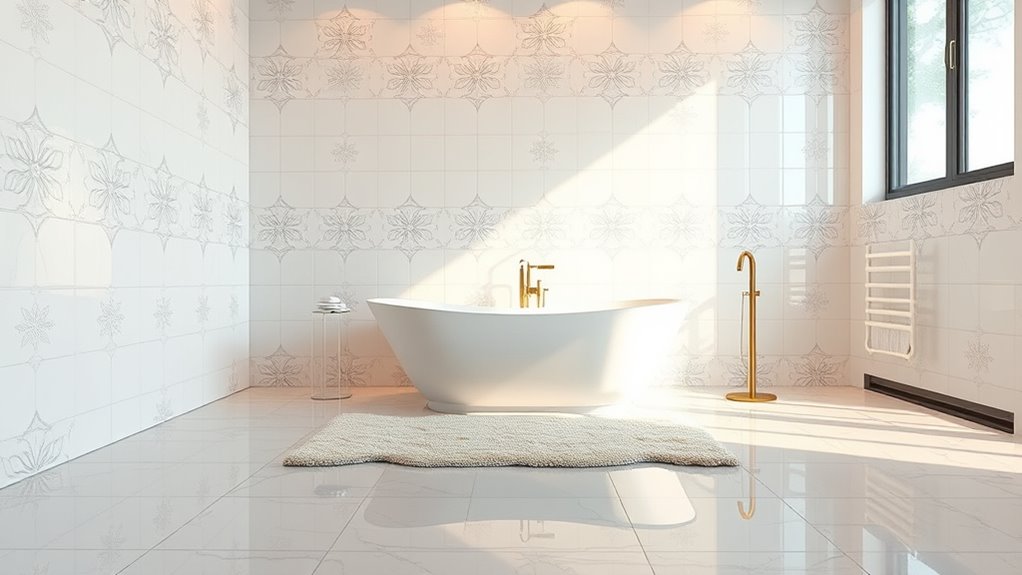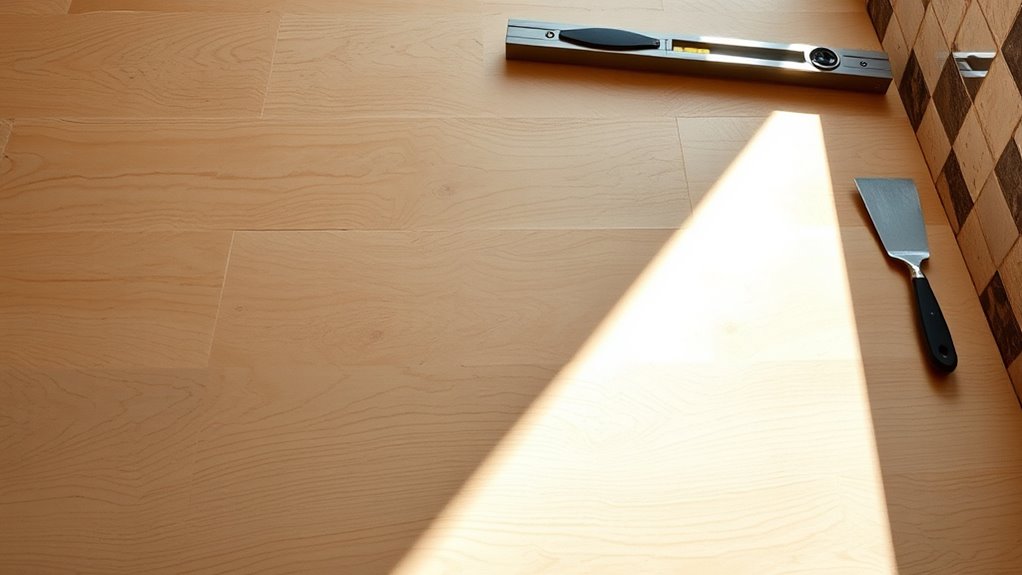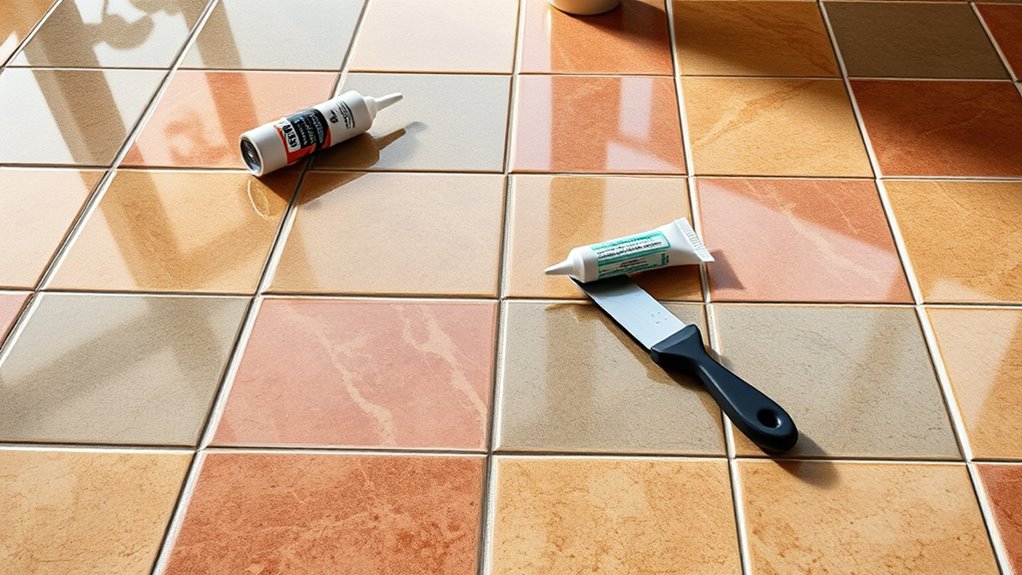You can use wall tiles on the floor safely by choosing ones designed with sufficient durability and a high abrasion resistance rating, like porcelain or strong ceramics. Make certain the subfloor is clean, level, and properly prepared. Use flexible, heavy-duty adhesive and sanded grout to guarantee stability. Seal the tiles and grout to protect against moisture and wear, and maintain the sol regularly. Understanding these key steps will help you confidently adapt wall tiles for flooring applications.
Understanding the Differences Between Wall and Floor Tiles

While wall and floor tiles might look similar at first glance, their design and durability differ considerably to meet specific functional demands. When you explore wall tile types, you’ll notice they tend to be thinner and less robust compared to floor tiles. This difference in tile thickness is essential because floor tiles must withstand heavier loads and foot traffic, while wall tiles primarily serve an aesthetic purpose. Using wall tiles on the floor without considering these factors can lead to premature damage. If you want the freedom to use wall tiles creatively on floors, you must carefully select types designed with adequate thickness and strength. Understanding these distinctions empowers you to make informed choices, ensuring safety and longevity in your tiling projects.
Assessing the Durability of Wall Tiles for Flooring
Before using wall tiles on your floor, you’ll need to evaluate their material strength and how well they can handle daily wear and tear. Checking slip resistance and impact ratings is essential to guarantee safety and longevity. These factors help determine if the tile can withstand foot traffic without cracking or becoming hazardous.
Tile Material Strength
The strength of tile material plays a crucial role when considering wall tiles for flooring applications. You’ll want to perform a thorough tile composition analysis to understand the structural integrity of the tile. Not all wall tiles are built to withstand foot traffic or weight, so knowing the tile’s makeup helps guarantee it won’t crack or break under pressure. Here’s a quick comparison for common tile materials:
| Tile Material | Composition | Structural Integrity Rating |
|---|---|---|
| Céramique | Clay, minerals | Modéré |
| Porcelaine | Denser clay, fired | Haut |
| Glass | Silica-based | Faible |
Choosing tiles with higher structural integrity means you can enjoy both style and durability without compromising safety or freedom in your space.
Wear and Tear Resistance
Since flooring endures constant foot traffic and environmental exposure, examining the wear and tear resistance of wall tiles is vital before repurposing them for floors. Wall tiles typically have lower wear resistance compared to floor tiles, making it important to select those rated for high durability. Look for tiles with a high PEI (Porcelain Enamel Institute) rating, indicating strong resistance to abrasion. Consider the tile’s surface finish—matte or textured surfaces often hide scratches better than glossy ones. To maximize longevity, follow maintenance tips like regular sweeping and using gentle cleaners to prevent surface damage. Avoid harsh chemicals or abrasive tools that can accelerate wear. By evaluating wear resistance carefully and maintaining your tiles properly, you guarantee your floor remains both functional and visually appealing over time.
Slip and Impact Ratings
Although wall tiles might look suitable for flooring, you’ll need to carefully assess their slip and impact ratings to confirm safety and durability. Slip resistance is critical, especially in areas prone to moisture, to prevent accidents. Look for tiles rated with a high coefficient of friction or a slip resistance rating designed for floors. Impact absorption is equally important; wall tiles often lack the strength to endure heavy foot traffic or dropped objects. Choosing tiles with proven impact absorption qualities means they can withstand daily wear without cracking or chipping. By prioritizing these ratings, you confirm your floor remains safe and long-lasting, giving you the freedom to enjoy your space without worry. Always verify manufacturer specifications before installing wall tile on floors.
Selecting the Right Wall Tiles Suitable for Floors
When choosing wall tiles for floor use, you’ll need to prioritize durability and slip resistance to guarantee safety and longevity. Not all wall tiles are designed to withstand foot traffic, so select those with a high PEI rating and textured surfaces to prevent slips. Consider tile size carefully; larger tiles offer fewer grout lines, creating a seamless look that enhances design aesthetics, but smaller tiles may provide better traction. Also, think about the tile material—porcelain and certain ceramics are better suited for floors due to their strength. Balancing these practical aspects with your style preferences lets you enjoy a unique floor that reflects your freedom in design without compromising safety. Always check manufacturer specifications to verify the wall tile meets floor-grade standards before installation.
Preparing the Subfloor for Wall Tile Installation

Before laying wall tiles on your floor, you’ll need to guarantee the subfloor is clean and perfectly level to create a stable foundation. Installing a moisture barrier is essential to prevent damage and maintain tile adhesion over time. Finally, choosing the right adhesive designed for floor use will help your tiles stay securely in place.
Surface propre et plane
Since wall tiles are designed for vertical surfaces, ensuring the subfloor is clean and level before installation is essential if you plan to use them on the floor. Tile surface preparation begins with thoroughly removing dust, debris, and any old adhesive residues. A clean base guarantees strong adhesion and prevents future tile damage. Next, assess the floor for uneven areas using a level. Floor leveling techniques, such as applying a self-leveling compound or patching low spots with a suitable mortar, help create a flat, stable foundation. Remember, even the slightest unevenness can cause tiles to crack or loosen under foot traffic. By carefully preparing the subfloor with these methods, you set the stage for a durable and visually appealing floor using wall tiles safely and effectively.
Moisture Barrier Installation
After confirming your subfloor is clean and level, the next step is to install a moisture barrier. This is vital for effective moisture management, especially when using wall tile on floors. You’ll want to select a barrier material compatible with your subfloor type—commonly polyethylene sheets or specialized membranes. Lay the barrier flat, overlapping seams by at least 6 inches, and tape them securely to prevent moisture seepage. Pay attention to installation techniques that avoid wrinkles or gaps, as those can compromise protection. Properly sealing edges against walls and any penetrations guarantees a continuous moisture barrier. By carefully installing this layer, you protect your tile and subfloor from moisture damage, enhancing durability and maintaining the freedom to enjoy your space without worry.
Proper Adhesive Selection
When choosing the right adhesive for wall tile on your floor, you’ll need to take into account factors like tile material, subfloor type, and moisture exposure. Selecting the proper adhesive type guarantees peak bonding strength, preventing tile movement or detachment. Here’s a quick guide to common adhesive options:
| Adhesive Type | Idéal pour |
|---|---|
| Thinset Mortar | Porcelain, ceramic tiles, concrete or cement backer boards |
| Mastic Adhesive | Dry areas with ceramic or glass tiles |
| Epoxy Adhesive | High moisture, heavy traffic, and natural stone tiles |
| Modified Thinset | Increased bonding strength, suitable for uneven surfaces |
| Polyurethane Adhesive | Flexible, ideal for wood subfloors and radiant heating |
Choose an adhesive compatible with your tile and subfloor. This will maximize durability and keep your floor safe and stable.
Using the Appropriate Adhesive and Grout for Floor Tiles

Although wall tile and floor tile may look similar, you’ll need to choose the right adhesive and grout to guarantee durability and safety on floors. For floor applications, select adhesive types designed to withstand heavier foot traffic and potential impact. Modified thin-set mortar is often the best choice, offering strong bonding and flexibility without compromising freedom in design. When it comes to grout options, opt for sanded grout for wider joints to prevent cracking and enhance stability. Unsanded grout suits narrower joints but may lack floor durability. Additionally, consider epoxy grout for high-traffic or moisture-prone areas due to its superior strength and stain resistance. By carefully selecting adhesive types and grout options tailored for floors, you ascertain that your wall tile transforms into a reliable, long-lasting floor surface.
Techniques for Properly Installing Wall Tiles on Floors
Three key techniques guarantee that wall tiles installed on floors remain durable and safe over time. First, you’ll want to confirm the floor surface is perfectly clean, level, and primed – this creates a solid foundation for your tiles. Next, applying a high-quality, flexible adhesive designed for floor use is vital; it prevents cracking and loosening under foot traffic. Finally, spacing your tiles correctly with consistent grout lines not only supports structural integrity but also allows for creative design patterns that express your style. Remember, following these essential installation tips guarantees your wall tiles perform well on floors, blending aesthetics with functionality. With the right approach, you can confidently transform any space without compromising durability or safety.
Sealing and Finishing Tiles to Enhance Floor Longevity
To guarantee your wall tiles maintain their appearance and withstand daily wear, sealing and finishing are essential steps after installation. You’ll want to explore sealing techniques that protect against moisture, stains, and abrasions, especially since wall tiles aren’t originally designed for floor use. Penetrating sealers work well by soaking into porous tiles, creating an invisible barrier without altering the tile’s look. For finishing options, consider applying a protective topcoat like a polyurethane or epoxy finish to enhance durability and slip resistance. These finishes add a subtle sheen while reinforcing the tile’s surface. By carefully selecting and applying these sealing techniques and finishing options, you make certain your floor remains resilient, visually appealing, and safe, granting you the freedom to enjoy a stylish, long-lasting tiled floor without worry.
Maintaining and Cleaning Wall Tile Floors Effectively
Maintaining and cleaning wall tile floors effectively requires consistent care and the right techniques to preserve their durability and appearance. Start by sweeping or vacuuming regularly to remove dirt and grit that can scratch the tiles. For deeper cleaning, use a mild detergent mixed with warm water, applying it with a soft mop or cloth. Avoid harsh chemicals or abrasive tools that might damage the tile surface. Incorporate maintenance tips like promptly wiping up spills to prevent staining and resealing grout lines periodically to keep them protected. By following these cleaning techniques, you’ll not only maintain the tile’s aesthetic but also extend the floor’s lifespan. With routine care, your wall tile floors will remain both beautiful and functional, giving you the freedom to enjoy a stylish, low-maintenance space.
When to Consider Professional Installation Assistance
While regular cleaning and upkeep can keep your wall tile floors looking great, the initial installation plays a significant role in their long-term performance. You should consider professional help if you’re unsure about preparing the subfloor correctly or selecting the right adhesive and grout. Installation expertise guarantees tiles are securely fixed, preventing cracking or shifting over time. If your project involves intricate patterns, uneven surfaces, or high-traffic areas, a skilled installer can assure durability and safety. Seeking professional help also saves you from costly repairs down the line. Ultimately, trusting experts allows you to enjoy your unique floor with confidence and freedom, knowing it was installed with precision and care. Don’t hesitate to invest in installation expertise for lasting results.




